A decade of declining births

Coupled with a sharply falling Hispanic fertility rate, the slide in fertility rates for the 20-24 age group has had the largest impact on Indiana’s decline in births.
The latest population estimates by the U.S. Census Bureau show that there were an estimated 81,075 births in Indiana in 2018.
This marks the state’s lowest annual tally since 1987 and continues Indiana’s precipitous decline in births and fertility rates that began a decade ago with the onset of the Great Recession (see Figure 1).
Figure 1: Indiana births and fertility rate
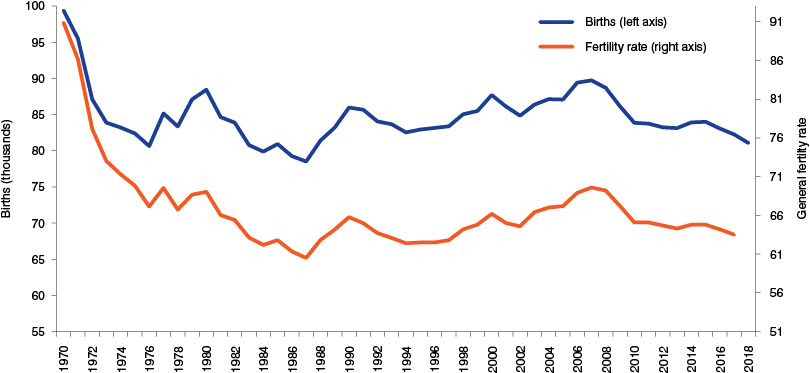
Note: The general fertility rate refers to the number of births per 1,000 women ages 15 to 44.
Source: IBRC, using data from the Indiana State Department of Health, the U.S. Centers for Disease Control and Prevention, and the U.S. Census Bureau
To help put these shifts in perspective, if Indiana’s average age-specific fertility rates between 2005 and 2007 had held steady over the last 11 years, the state would have had approximately 77,400 more births over this span (see Figure 2).
Figure 2: Annual number of Indiana births compared to expected births at 2005-2007 rates
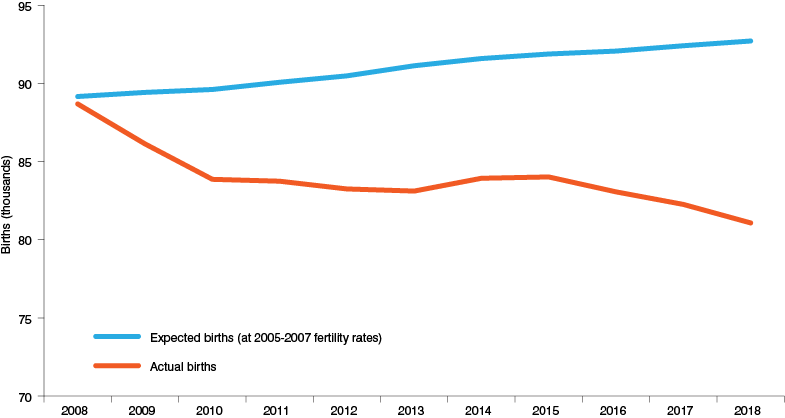
Source: IBRC, using data from the Indiana State Department of Health and the U.S. Census Bureau
This trend is not unique to Indiana. In fact, the U.S. Centers for Disease Control and Prevention reports that the nation set a record-low fertility rate in 2017.1
So what is driving this decline in the number of births? This article explores Indiana’s fertility trends by age group and race and ethnicity in an effort to answer this question.
Age-specific fertility rates
Figure 3 highlights the tremendous shifts in fertility rates by age that Indiana has seen over the past three decades. In the early 1990s, for instance, Hoosier teens were nearly as likely to give birth as women ages 30 to 34. By 2017, however, the fertility rate for women in this latter age group is more than four times greater than that of teens. Moreover, the state’s fertility rate for women ages 30 to 34 has now surpassed the rapidly declining rate for those between ages 20 and 24.
Figure 3: Indiana age-specific birth rates
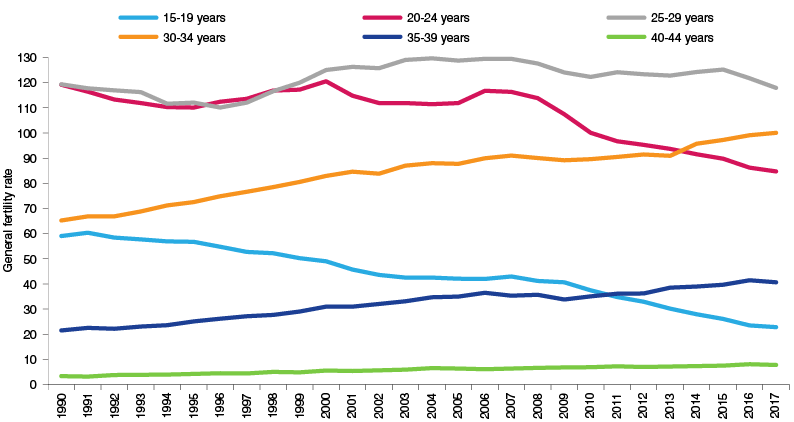
Note: The general fertility rate refers to the number of births per 1,000 women ages 15 to 44.
Source: U.S. Centers for Disease Control and Prevention
Over the last decade, this slide in fertility rates for the 20-24 age group has had the largest impact on Indiana’s decline in births. Table 1 compares the total number of births by age group in the state between 2008 and 2017 against the number of births we would have expected over that same period if age-specific fertility rates observed just before the start of the Great Recession had held steady. For the 20-24 group, the gap between actual and expected births is more than 44,000 over this 10-year period. The decline in fertility among younger adults has been offset somewhat by rising rates for Hoosier women in their 30s, but these increases are not nearly strong enough to make up the difference.
Table 1: Indiana’s total births by age group between 2008 and 2017 compared to expected births at 2005-2007 rates
| Age group | 15-19 | 20-24 | 25-29 | 30-34 | 35-39 | 40-44 | Total 15-44 |
|---|---|---|---|---|---|---|---|
| Actual births | 72,142 | 221,701 | 260,629 | 193,213 | 77,388 | 15,128 | 840,201 |
| Expected births at 2005-2007 fertility rates | 95,850 | 265,910 | 274,005 | 185,470 | 73,294 | 13,286 | 907,815 |
| Numeric difference | -23,708 | -44,209 | -13,376 | 7,743 | 4,094 | 1,842 | -67,614 |
| Percent difference | -24.7% | -16.6% | -4.9% | 4.2% | 5.6% | 13.9% | -7.4% |
Source: IBRC, using data from the U.S. Centers for Disease Control and Prevention and the U.S. Census Bureau
Shifts in fertility by race and ethnicity
Changes in fertility among race and ethnic groups in Indiana have been equally as dramatic, particularly for the state’s Hispanic population. Figure 4 shows that the fertility rate for Indiana’s Hispanic residents increased by 52 percent between 1995 and its peak in 2005. Since 2007, however, the Hispanic fertility rate has fallen sharply and is now more in line with other groups in the state.
Figure 4: Indiana birth rates by race and ethnicity
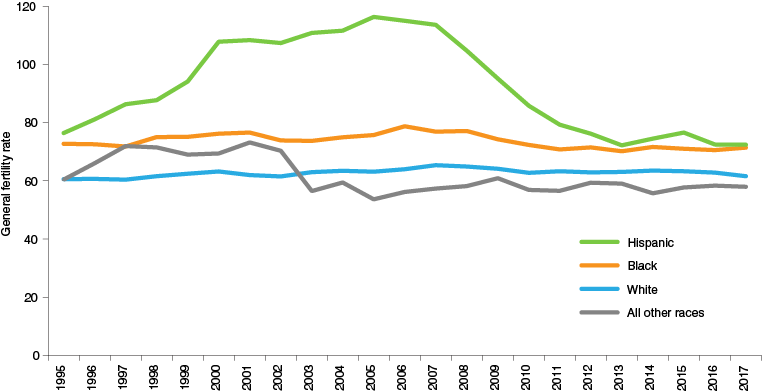
Note: The general fertility rate refers to the number of births per 1,000 women ages 15 to 44. Hispanic is an ethnicity, not a race. Hispanic residents may be of any race. All references to race groups exclude Hispanic residents of that race.
Source: U.S. Centers for Disease Control and Prevention
The story behind this roller-coaster ride is that the 1990s and 2000s was a period of strong growth in Indiana’s Hispanic population, with a threefold increase in the size of this group in just a 14-year period between 1994 and 2008. In fact, this Hispanic growth spurred a bit of a turnaround for Indiana’s population growth trend. The state had a net out-migration of residents during the 1960s, 1970s and 1980s; but that trend reversed over the next two decades. Much of this improved net migration between 1990 and 2010 was driven by Hispanic residents moving to the state, as the Hispanic population accounted for 77 percent of all net migration to Indiana over this 20-year period.2
A significant part of this Hispanic growth was driven by foreign-born residents, which tended to have much higher fertility rates than the Indiana population as a whole. With the onset of the Great Recession, however, growth in Indiana’s foreign-born Hispanic population came to an abrupt stop. Now a larger share of Indiana’s Hispanic residents in the prime child-bearing age groups were raised in the U.S., and they are making many of the same lifestyle choices as their peers in other race and ethnic groups, such as delaying the start of a family to pursue education and start a career.3
Figure 5 shows how these shifting fertility trends translate to the number of births. Between 1995 and 2007, the number of births for Hispanic residents in Indiana increased from roughly 2,500 to 8,800, but have since declined to around 7,700 births in 2017. The number of births for the state’s black population climbed from nearly 8,700 in 1995 to approximately 10,300 in 2007. The number of births for Indiana’s black population has continued to grow over the last decade, but at a much slower rate than before the recession. Meanwhile, the number of births for the state’s white population has dropped by more than 7,900 over the last 10 years.
Figure 5: Indiana births by race and ethnicity
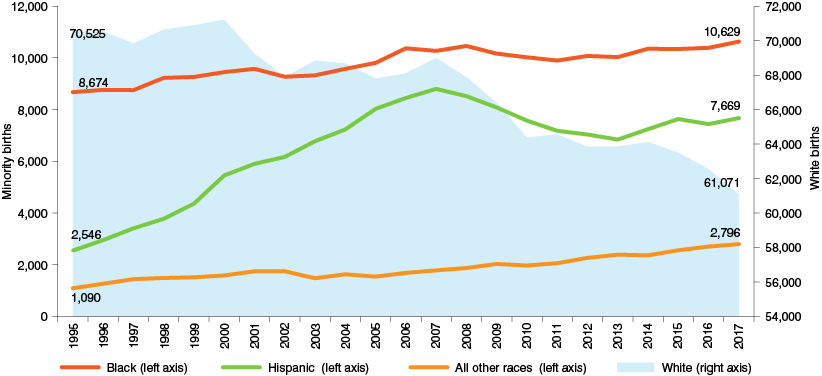
Note: Hispanic is an ethnicity, not a race. Hispanic residents may be of any race. All references to race groups exclude Hispanic residents of that race.
Source: U.S. Centers for Disease Control and Prevention
Table 2 shows the comparison in the total number of births for race and ethnic groups over the past decade to the number of births we would have expected over that period had the pre-recession, age-specific fertility rates for each of these groups held constant. Each group has fewer births than would have been expected based on the 2005-2007 rates, with the white population showing the largest difference at roughly 31,800. As for the percent difference, the dramatic shifts in Hispanic fertility rates results in a 24 percent gap between expected births and the actual count over the last 10 years.
Table 2: Indiana’s total births by race and ethnicity between 2008 and 2017 compared to expected births at 2005-2007 rates
| Race and ethnic groups | White | Black | Hispanic | All other races | Total |
|---|---|---|---|---|---|
| Actual births | 642,187 | 102,362 | 75,199 | 22,985 | 842,733 |
| Expected births at 2005-2007 fertility rates | 673,990 | 111,395 | 99,343 | 24,185 | 908,913 |
| Numeric difference | -31,803 | -9,033 | -24,144 | -1,200 | -66,180 |
| Percent difference | -4.7% | -8.1% | -24.3% | -5.0% | -7.3% |
Note: Hispanic is an ethnicity, not a race. Hispanic residents may be of any race. All references to race groups exclude Hispanic residents of that race.
Source: IBRC, using data from the U.S. Centers for Disease Control and Prevention and the U.S. Census Bureau
Conclusion
The Great Recession impacted Indiana in a variety of ways. By most economic and labor force measures, the recession was put in the rearview mirror long ago. In some other areas, such as residential construction or domestic migration, the recovery has been slower, but there has still been real improvement.
For fertility rates and births, however, there are no signs that trends over the past decade will change any time soon. Young adults continue to delay starting a family, and when they do start, they have fewer children than generations past. The effects of these structural shifts were masked for a time by strong growth in the state’s foreign-born Hispanic population, but this growth stopped in the late 2000s, and Hispanic fertility rates now resemble that of other groups in the state. Given this new reality, Indiana is likely in for a sustained period of relatively low birth totals.
Notes
- J. A. Martin, B. E. Hamilton, M. J. K. Osterman, A. K. Driscoll, P. Drake, "Births: Final data for 2017," National Vital Statistics Reports, November 7, 2018, www.cdc.gov/nchs/data/nvsr/nvsr67/nvsr67_08-508.pdf.
- Richelle Winkler, Kenneth M. Johnson, Cheng Cheng, Jim Beaudoin, Paul R. Voss, and Katherine J. Curtis, “Age-Specific Net Migration Estimates for U.S. Counties, 1950-2010,” Applied Population Laboratory, University of Wisconsin–Madison, 2013, www.netmigration.wisc.edu/.
- Sabrina Tavernise, “Why Birthrates among Hispanic Americans Have Plummeted,” New York Times, March 7, 2019, www.nytimes.com/2019/03/07/us/us-birthrate-hispanics-latinos.html.
